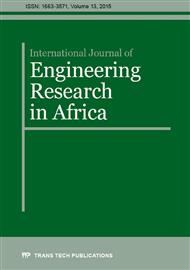[1]
Kolsky, H. (1949) "An investigation of mechanical properties of materials at very high rates of loading" Proceedings of the Physical Society. Section B, Vol. 62 [.
DOI: 10.1088/0370-1301/62/11/302
Google Scholar
[2]
Costin, L. S., Duffy, J., and Freund, L. B. (1977) "Fracture Initiation in Metals Under Stress Wave Loading Conditions" Fast Fracture and Crack Arrest, American Science for Testing Materials, Philadelphia, PA, ASTM STP 627,p.301–318
DOI: 10.1520/stp27395s
Google Scholar
[3]
Stroppe, H., Schreppel, U., and Clos, R. (1978) Proceeding of The Seventh Conference of Materials Testing, Budapest, p.329.
Google Scholar
[4]
Tanaka, K., and Kagatsume, T. (1980) "Impact Bending Test on Steel at Low Temperatures," Bull. JSME, 23, p.1736–1744.
DOI: 10.1299/jsme1958.23.1736
Google Scholar
[5]
Mines, R. A. W., and Ruiz, C. (1985) "The Dynamic Behavior of the Instrumented Charpy-Test," J. Phys. France, 46 p.187–196.
Google Scholar
[6]
Nakano, M., Kishida, K., and Watanabe, Y. (1992) "Mixed-Mode Impact Fracture Tests Using Center-Notched Disk Specimens," Proceedings of the International Symposium on Impact Engineering, Vol. 2, p.581–586.
Google Scholar
[7]
Nwosu, S. N., Hui, D., and Dutta, P. K. (2003) "Dynamic Mode II Delamination Fracture of Unidirectional Graphite/Epoxy Composites," Composites, Part B, 34, p.303–316.
DOI: 10.1016/s1359-8368(02)00039-2
Google Scholar
[8]
Guo, W. G., Li, Y. L., and Liu, Y. Y. (1997) "Analytical and Experimental Determination of Dynamic Impact Stress Intensity Factor for 40Cr Steel,"Theor. Appl. Fract. Mech., 26, p.29–34
Google Scholar
[9]
Rubio, L., Fernández-Sáez, J., and Navarro, C. (2003) "Determination of Dynamic Fracture-Initiation Toughness Using Three-Point Bending Tests in a Modified Hopkinson Pressure Bar," Exp. Mech., 43, p.379–386.
DOI: 10.1007/bf02411342
Google Scholar
[10]
Corran, R. S. J., Benitez, F. G., Harding, J., Ruiz, C., and Nojima, T. (1983) "Towards the Development of a Dynamic Fracture Initiation Test," Application of Fracture Mechanics to Materials and Structures, G. C. Sih, E. Sommer, and W. Dahl, eds., Martinus Nijhoff Publishers, The Hague, p.443–454.
DOI: 10.1007/978-94-009-6146-3_27
Google Scholar
[11]
Ogawa, K., and Higashida, F. (1990) "Impact Three-Point Bending Tests by Applying Ramped Incident Wave," Reinforced Plastics, 36, p.123–129, in Japanese.
Google Scholar
[12]
Homma, H., Kanto, Y., and Tanaka, K. (1991) "Cleavage Fracture Under Short Pulse Loading," Colloq. Phys., 1, p.589–596.
DOI: 10.1051/jp4:1991383
Google Scholar
[13]
Bacon, C. (1993) "Mesure de la tenacite dynamique de materiaux fragiles en flexion-trois-points ahaute temperature—Utilisation des barres de Hopkinson," Ph.D. thesis, University of Bordeaux, France
Google Scholar
[14]
Weerasooriya, T., Moy, P., Casem, D., Cheng, M., and Chen, W. (2006) "A Four-Point Bend Technique to Determine Dynamic Fracture Toughness of Ceramics," J. Am. Ceram. Soc., 89, p.990–995.
DOI: 10.1111/j.1551-2916.2005.00896.x
Google Scholar
[15]
Jiang, F., and Vecchio, K. S. (2007) "Experimental Investigation of Dynamic Effects in a Two-Bar/Three-Point Bend Fracture Test," Rev. Sci. Instrum., 78, p.063903.
DOI: 10.1063/1.2746630
Google Scholar
[16]
W. Chen, B. Zhang and M. J. Forrestal (1998) "A Split Hopkinson Bar Technique for Low-impedance Materials" Experimental Mechanics
DOI: 10.1007/bf02331109
Google Scholar
[17]
Song Shuncheng, and Tian Shiyu, (1992) "Dynamic Tensile Testing of Materials Using the Hollow Hopkinson Bars Instead of the Solid Hopkinson Bars", Explosion and Shock Waves, 62-67( in Chinese).
Google Scholar
[18]
Fengchua Zhou, Jean-Francois Molinari and Yulong Li. (2004) "Three-dimensional numerical simulations of dynamic fracture in silicon carbide reinforced aluminum",. Engineering Fracture Mechanics., 71(9-10):1357-1378.
DOI: 10.1016/s0013-7944(03)00168-1
Google Scholar
[19]
Rokach, I. V. (1997) "On the Influence of One-Point-Bend Impact Test Parameters on Dynamic Stress Intensity Factor Variation," Mater. Sci. Eng., A, 234–236, p.838–841.
DOI: 10.1016/s0921-5093(97)00303-1
Google Scholar
[20]
Rokach, I. V. (1994) "Comparison of Simplified Methods of Dynamic Stress Intensity Actors Evaluation," Theor Appl. Mech., 32, p.203–212.
Google Scholar
[21]
Rokach, I. V. (2003), "On the Numerical Evaluation of the Anvil Force for Accurate Dynamic Stress Intensity Factor Determination," Eng. Fract. Mech., 70, p.2059–2074.
DOI: 10.1016/s0013-7944(02)00256-4
Google Scholar
[22]
Nishioka, T., and Atluri, S. N. (1982) "A Method for Determining Dynamic Stress Intensity Factors From COD Measurement at the Notch Mouth in Dynamic Tear Testing," Eng. Fract. Mech., 16, p.333–339.
DOI: 10.1016/0013-7944(82)90112-6
Google Scholar


